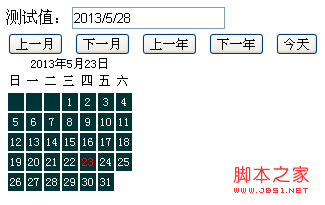知识点:
主要是对Date对象的使用。(下面的介绍内容来自网络)
创建 Date 对象的语法:
var myDate=new Date()
Date 对象会自动把当前日期和时间保存为其初始值。
参数形式有以下5种:
new Date("month dd,yyyy hh:mm:ss");
new Date("month dd,yyyy");
new Date(yyyy,mth,dd,hh,mm,ss);
new Date(yyyy,mth,dd);
new Date(ms);
注意:最后一种形式,参数表示的是需要创建的时间和GMT时间1970年1月1日之间相差的毫秒数。
参数的含义如下:
month:用英文表示月份名称,从January到December
mth:用整数表示月份,从(1月)到11(12月)
dd:表示一个月中的第几天,从1到31
yyyy:四位数表示的年份
hh:小时数,从0(午夜)到23(晚11点)
mm:分钟数,从0到59的整数
ss:秒数,从0到59的整数
ms:毫秒数,为大于等于0的整数
Date对象的方法:
getDate() 从 Date 对象返回一个月中的某一天 (1 ~ 31)。
getDay() 从 Date 对象返回一周中的某一天 (0 ~ 6)。
getMonth() 从 Date 对象返回月份 (0 ~ 11)。
getFullYear() 从 Date 对象以四位数字返回年份。
getYear() 请使用 getFullYear() 方法代替。
getHours() 返回 Date 对象的小时 (0 ~ 23)。
getMinutes() 返回 Date 对象的分钟 (0 ~ 59)。
getSeconds() 返回 Date 对象的秒数 (0 ~ 59)。
getMilliseconds() 返回 Date 对象的毫秒(0 ~ 999)。
getTime() 返回 1970 年 1 月 1 日至今的毫秒数。
getTimezoneOffset() 返回本地时间与格林威治标准时间 (GMT) 的分钟差。
getUTCDate() 根据世界时从 Date 对象返回月中的一天 (1 ~ 31)。
getUTCDay() 根据世界时从 Date 对象返回周中的一天 (0 ~ 6)。
getUTCMonth() 根据世界时从 Date 对象返回月份 (0 ~ 11)。
getUTCFullYear() 根据世界时从 Date 对象返回四位数的年份。
getUTCHours() 根据世界时返回 Date 对象的小时 (0 ~ 23)。
getUTCMinutes() 根据世界时返回 Date 对象的分钟 (0 ~ 59)。
getUTCSeconds() 根据世界时返回 Date 对象的秒钟 (0 ~ 59)。
getUTCMilliseconds() 根据世界时返回 Date 对象的毫秒(0 ~ 999)。
parse() 返回1970年1月1日午夜到指定日期(字符串)的毫秒数。
setDate() 设置 Date 对象中月的某一天 (1 ~ 31)。
setMonth() 设置 Date 对象中月份 (0 ~ 11)。
setFullYear() 设置 Date 对象中的年份(四位数字)。
setYear() 请使用 setFullYear() 方法代替。
setHours() 设置 Date 对象中的小时 (0 ~ 23)。
setMinutes() 设置 Date 对象中的分钟 (0 ~ 59)。
setSeconds() 设置 Date 对象中的秒钟 (0 ~ 59)。
setMilliseconds() 设置 Date 对象中的毫秒 (0 ~ 999)。
setTime() 以毫秒设置 Date 对象。
setUTCDate() 根据世界时设置 Date 对象中月份的一天 (1 ~ 31)。
setUTCMonth() 根据世界时设置 Date 对象中的月份 (0 ~ 11)。
setUTCFullYear() 根据世界时设置 Date 对象中的年份(四位数字)。
setUTCHours() 根据世界时设置 Date 对象中的小时 (0 ~ 23)。
setUTCMinutes() 根据世界时设置 Date 对象中的分钟 (0 ~ 59)。
setUTCSeconds() 根据世界时设置 Date 对象中的秒钟 (0 ~ 59)。
setUTCMilliseconds() 根据世界时设置 Date 对象中的毫秒 (0 ~ 999)。
toSource() 返回该对象的源代码。
toString() 把 Date 对象转换为字符串。
toTimeString() 把 Date 对象的时间部分转换为字符串。
toDateString() 把 Date 对象的日期部分转换为字符串。
toGMTString() 请使用 toUTCString() 方法代替。 1 3
toUTCString() 根据世界时,把 Date 对象转换为字符串。
toLocaleString() 根据本地时间格式,把 Date 对象转换为字符串。
toLocaleTimeString() 根据本地时间格式,把 Date 对象的时间部分转换为字符串。
toLocaleDateString() 根据本地时间格式,把 Date 对象的日期部分转换为字符串。
UTC() 根据世界时返回 1997 年 1 月 1 日 到指定日期的毫秒数。
valueOf() 返回 Date 对象的原始值。
var objDate=new Date([arguments list]);
简单日历实现:
效果:

代码:
测试值:
<script> <br><br>var Calendar=function(year,monthNum,parent){ <BR>this.year=year; <BR>this.parent=parent; <BR>this.monthNum=monthNum-1; <BR>function isLeapYear(y){ <BR>return (y>0)&&!(y%4)&&((y%100)||!(y%400)); <BR>} <BR>this.numDays=[31,isLeapYear(this.year)?29:28,31,30,31,30,31,31,30,31,30,31][this.monthNum]; <BR>this.weekDays=["日","一","二","三","四","五","六"]; <BR>this.nowDate=new Date; <BR>this.init(); <BR>} <br><br>Calendar.prototype={ <BR>setMonthNum:function(monthNum){ <BR>this.monthNum=monthNum-1; <BR>}, <BR>getMonthNum:function(){ <BR>return this.monthNum+1; <BR>}, <BR>setYearNum:function(year){ <BR>this.year=year; <BR>}, <BR>getYearNum:function(){ <BR>return this.year; <BR>}, <BR>init:function(){ <BR>this.setup(this.parent); <BR>}, <BR>reflesh:function(){ <BR>this.setup(this.parent); <BR>}, <BR>setup:function(id){ <BR>var date=this.nowDate; <BR>var cal=document.getElementById(id); <BR>cal.innerHTML=""; <BR>var calDiv=document.createElement("div"); <BR>var tab=document.createElement("table"); <BR>cal.appendChild(calDiv); <BR>calDiv.innerHTML=this.getSummary(); <BR>cal.appendChild(tab); <BR>calDiv.className="detail" <BR>this.thead=document.createElement("thead"); <BR>this.tbody=document.createElement("tbody"); <BR>this.tfoot=document.createElement("tfoot"); <BR>this.tr=document.createElement("tr"); <BR>this.td=document.createElement("td"); <br><br>tab.appendChild(this.thead); <BR>tab.appendChild(this.tbody); <BR>this.setThead(); <BR>this.create(); <br><br>}, <BR>setThead:function(){ <BR>var day=this.weekDays; <BR>var tr=this.tr.cloneNode(true); <BR>this.thead.appendChild(tr); <BR>for(var i=0;i<7;i++){ <BR>var td=this.td.cloneNode(true); <BR>tr.appendChild(td); <BR>td.innerHTML=day[i]; <BR>} <BR>}, <BR>create:function(){ <BR>var day=new Date(this.year,this.monthNum,1); <BR>var tr=this.tr.cloneNode(true); <BR>var dayCount=this.numDays; <BR>var that=this; <br><br>that.tbody.appendChild(tr); <BR>for(var j=0;j<day.getDay();j++){ <BR>var td=that.td.cloneNode(true); <BR>tr.appendChild(td); <BR>td.innerHTML=" "; <BR>} <BR>for(var i=1;i<=dayCount;i++){ <BR>if((j+i)%7-1==0){ <BR>tr=that.tr.cloneNode(true); <BR>that.tbody.appendChild(tr); <BR>} <BR>var td=that.td.cloneNode(true); <BR>var s=i; <BR>if(i==that.nowDate.getDate()){ <BR>s="<font color='red'>"+i+""; <BR>} <BR>td.innerHTML=s; <BR>td.style.cursor="pointer"; <BR>td.onclick=function(){ <BR>document.getElementById("calendar_value").value=(that.getYearNum()+"/"+that.getMonthNum()+"/"+this.innerHTML) <BR>} <BR>td.onmouseover=function(){ <BR>this.style.background="#fff"; <BR>this.style.color="#033" <BR>} <BR>td.onmouseout=function(){ <BR>this.style.background=""; <BR>this.style.color="#fff" <BR>} <BR>tr.appendChild(td); <BR>} <BR>}, <BR>getSummary:function(){ <BR>var date=this.nowDate; <BR>return this.year+"年"+(this.monthNum+1)+"月"+date.getDate()+"日"; <BR>} <BR>} <BR>var cal=new Calendar(2013,5,"calendar"); <BR>cal.init(); <br><br>document.getElementById("cal_prev").onclick=function(){ <BR>cal.monthNum--; <BR>if(cal.getMonthNum()<1){ <BR>cal.setMonthNum(12); <BR>cal.year--; <BR>} <BR>cal.reflesh(); <BR>} <BR>document.getElementById("cal_next").onclick=function(){ <BR>cal.monthNum++ <BR>if(cal.getMonthNum()>12){ <BR>cal.setMonthNum(1); <BR>cal.year++; <BR>} <BR>cal.reflesh(); <BR>} <BR>document.getElementById("cal_today").onclick=function(){ <BR>cal.setYearNum((new Date).getFullYear()); <BR>cal.setMonthNum((new Date).getMonth()+1) <BR>cal.reflesh(); <BR>} <BR>document.getElementById("cal_preyear").onclick=function(){ <BR>cal.setYearNum(cal.getYearNum()-1); <BR>cal.reflesh(); <BR>} <BR>document.getElementById("cal_nextyear").onclick=function(){ <BR>cal.setYearNum(cal.getYearNum()+1); <BR>cal.reflesh(); <BR>} <BR></script>
总结:
以上代码未加注释,写得有点急。以后再整理一下,许多功能未实现。
主要是对Date对象的使用。(下面的介绍内容来自网络)
创建 Date 对象的语法:
var myDate=new Date()
Date 对象会自动把当前日期和时间保存为其初始值。
参数形式有以下5种:
new Date("month dd,yyyy hh:mm:ss");
new Date("month dd,yyyy");
new Date(yyyy,mth,dd,hh,mm,ss);
new Date(yyyy,mth,dd);
new Date(ms);
注意:最后一种形式,参数表示的是需要创建的时间和GMT时间1970年1月1日之间相差的毫秒数。
参数的含义如下:
month:用英文表示月份名称,从January到December
mth:用整数表示月份,从(1月)到11(12月)
dd:表示一个月中的第几天,从1到31
yyyy:四位数表示的年份
hh:小时数,从0(午夜)到23(晚11点)
mm:分钟数,从0到59的整数
ss:秒数,从0到59的整数
ms:毫秒数,为大于等于0的整数
Date对象的方法:
getDate() 从 Date 对象返回一个月中的某一天 (1 ~ 31)。
getDay() 从 Date 对象返回一周中的某一天 (0 ~ 6)。
getMonth() 从 Date 对象返回月份 (0 ~ 11)。
getFullYear() 从 Date 对象以四位数字返回年份。
getYear() 请使用 getFullYear() 方法代替。
getHours() 返回 Date 对象的小时 (0 ~ 23)。
getMinutes() 返回 Date 对象的分钟 (0 ~ 59)。
getSeconds() 返回 Date 对象的秒数 (0 ~ 59)。
getMilliseconds() 返回 Date 对象的毫秒(0 ~ 999)。
getTime() 返回 1970 年 1 月 1 日至今的毫秒数。
getTimezoneOffset() 返回本地时间与格林威治标准时间 (GMT) 的分钟差。
getUTCDate() 根据世界时从 Date 对象返回月中的一天 (1 ~ 31)。
getUTCDay() 根据世界时从 Date 对象返回周中的一天 (0 ~ 6)。
getUTCMonth() 根据世界时从 Date 对象返回月份 (0 ~ 11)。
getUTCFullYear() 根据世界时从 Date 对象返回四位数的年份。
getUTCHours() 根据世界时返回 Date 对象的小时 (0 ~ 23)。
getUTCMinutes() 根据世界时返回 Date 对象的分钟 (0 ~ 59)。
getUTCSeconds() 根据世界时返回 Date 对象的秒钟 (0 ~ 59)。
getUTCMilliseconds() 根据世界时返回 Date 对象的毫秒(0 ~ 999)。
parse() 返回1970年1月1日午夜到指定日期(字符串)的毫秒数。
setDate() 设置 Date 对象中月的某一天 (1 ~ 31)。
setMonth() 设置 Date 对象中月份 (0 ~ 11)。
setFullYear() 设置 Date 对象中的年份(四位数字)。
setYear() 请使用 setFullYear() 方法代替。
setHours() 设置 Date 对象中的小时 (0 ~ 23)。
setMinutes() 设置 Date 对象中的分钟 (0 ~ 59)。
setSeconds() 设置 Date 对象中的秒钟 (0 ~ 59)。
setMilliseconds() 设置 Date 对象中的毫秒 (0 ~ 999)。
setTime() 以毫秒设置 Date 对象。
setUTCDate() 根据世界时设置 Date 对象中月份的一天 (1 ~ 31)。
setUTCMonth() 根据世界时设置 Date 对象中的月份 (0 ~ 11)。
setUTCFullYear() 根据世界时设置 Date 对象中的年份(四位数字)。
setUTCHours() 根据世界时设置 Date 对象中的小时 (0 ~ 23)。
setUTCMinutes() 根据世界时设置 Date 对象中的分钟 (0 ~ 59)。
setUTCSeconds() 根据世界时设置 Date 对象中的秒钟 (0 ~ 59)。
setUTCMilliseconds() 根据世界时设置 Date 对象中的毫秒 (0 ~ 999)。
toSource() 返回该对象的源代码。
toString() 把 Date 对象转换为字符串。
toTimeString() 把 Date 对象的时间部分转换为字符串。
toDateString() 把 Date 对象的日期部分转换为字符串。
toGMTString() 请使用 toUTCString() 方法代替。 1 3
toUTCString() 根据世界时,把 Date 对象转换为字符串。
toLocaleString() 根据本地时间格式,把 Date 对象转换为字符串。
toLocaleTimeString() 根据本地时间格式,把 Date 对象的时间部分转换为字符串。
toLocaleDateString() 根据本地时间格式,把 Date 对象的日期部分转换为字符串。
UTC() 根据世界时返回 1997 年 1 月 1 日 到指定日期的毫秒数。
valueOf() 返回 Date 对象的原始值。
var objDate=new Date([arguments list]);
简单日历实现:
效果:

代码:
复制代码 代码如下:
测试值:
<script> <br><br>var Calendar=function(year,monthNum,parent){ <BR>this.year=year; <BR>this.parent=parent; <BR>this.monthNum=monthNum-1; <BR>function isLeapYear(y){ <BR>return (y>0)&&!(y%4)&&((y%100)||!(y%400)); <BR>} <BR>this.numDays=[31,isLeapYear(this.year)?29:28,31,30,31,30,31,31,30,31,30,31][this.monthNum]; <BR>this.weekDays=["日","一","二","三","四","五","六"]; <BR>this.nowDate=new Date; <BR>this.init(); <BR>} <br><br>Calendar.prototype={ <BR>setMonthNum:function(monthNum){ <BR>this.monthNum=monthNum-1; <BR>}, <BR>getMonthNum:function(){ <BR>return this.monthNum+1; <BR>}, <BR>setYearNum:function(year){ <BR>this.year=year; <BR>}, <BR>getYearNum:function(){ <BR>return this.year; <BR>}, <BR>init:function(){ <BR>this.setup(this.parent); <BR>}, <BR>reflesh:function(){ <BR>this.setup(this.parent); <BR>}, <BR>setup:function(id){ <BR>var date=this.nowDate; <BR>var cal=document.getElementById(id); <BR>cal.innerHTML=""; <BR>var calDiv=document.createElement("div"); <BR>var tab=document.createElement("table"); <BR>cal.appendChild(calDiv); <BR>calDiv.innerHTML=this.getSummary(); <BR>cal.appendChild(tab); <BR>calDiv.className="detail" <BR>this.thead=document.createElement("thead"); <BR>this.tbody=document.createElement("tbody"); <BR>this.tfoot=document.createElement("tfoot"); <BR>this.tr=document.createElement("tr"); <BR>this.td=document.createElement("td"); <br><br>tab.appendChild(this.thead); <BR>tab.appendChild(this.tbody); <BR>this.setThead(); <BR>this.create(); <br><br>}, <BR>setThead:function(){ <BR>var day=this.weekDays; <BR>var tr=this.tr.cloneNode(true); <BR>this.thead.appendChild(tr); <BR>for(var i=0;i<7;i++){ <BR>var td=this.td.cloneNode(true); <BR>tr.appendChild(td); <BR>td.innerHTML=day[i]; <BR>} <BR>}, <BR>create:function(){ <BR>var day=new Date(this.year,this.monthNum,1); <BR>var tr=this.tr.cloneNode(true); <BR>var dayCount=this.numDays; <BR>var that=this; <br><br>that.tbody.appendChild(tr); <BR>for(var j=0;j<day.getDay();j++){ <BR>var td=that.td.cloneNode(true); <BR>tr.appendChild(td); <BR>td.innerHTML=" "; <BR>} <BR>for(var i=1;i<=dayCount;i++){ <BR>if((j+i)%7-1==0){ <BR>tr=that.tr.cloneNode(true); <BR>that.tbody.appendChild(tr); <BR>} <BR>var td=that.td.cloneNode(true); <BR>var s=i; <BR>if(i==that.nowDate.getDate()){ <BR>s="<font color='red'>"+i+""; <BR>} <BR>td.innerHTML=s; <BR>td.style.cursor="pointer"; <BR>td.onclick=function(){ <BR>document.getElementById("calendar_value").value=(that.getYearNum()+"/"+that.getMonthNum()+"/"+this.innerHTML) <BR>} <BR>td.onmouseover=function(){ <BR>this.style.background="#fff"; <BR>this.style.color="#033" <BR>} <BR>td.onmouseout=function(){ <BR>this.style.background=""; <BR>this.style.color="#fff" <BR>} <BR>tr.appendChild(td); <BR>} <BR>}, <BR>getSummary:function(){ <BR>var date=this.nowDate; <BR>return this.year+"年"+(this.monthNum+1)+"月"+date.getDate()+"日"; <BR>} <BR>} <BR>var cal=new Calendar(2013,5,"calendar"); <BR>cal.init(); <br><br>document.getElementById("cal_prev").onclick=function(){ <BR>cal.monthNum--; <BR>if(cal.getMonthNum()<1){ <BR>cal.setMonthNum(12); <BR>cal.year--; <BR>} <BR>cal.reflesh(); <BR>} <BR>document.getElementById("cal_next").onclick=function(){ <BR>cal.monthNum++ <BR>if(cal.getMonthNum()>12){ <BR>cal.setMonthNum(1); <BR>cal.year++; <BR>} <BR>cal.reflesh(); <BR>} <BR>document.getElementById("cal_today").onclick=function(){ <BR>cal.setYearNum((new Date).getFullYear()); <BR>cal.setMonthNum((new Date).getMonth()+1) <BR>cal.reflesh(); <BR>} <BR>document.getElementById("cal_preyear").onclick=function(){ <BR>cal.setYearNum(cal.getYearNum()-1); <BR>cal.reflesh(); <BR>} <BR>document.getElementById("cal_nextyear").onclick=function(){ <BR>cal.setYearNum(cal.getYearNum()+1); <BR>cal.reflesh(); <BR>} <BR></script>
总结:
以上代码未加注释,写得有点急。以后再整理一下,许多功能未实现。
相关标签:
来源:php.cn
本站声明
本文内容由网友自发贡献,版权归原作者所有,本站不承担相应法律责任。如您发现有涉嫌抄袭侵权的内容,请联系admin@php.cn
作者最新文章
-
2024-09-20 15:51:33
-
2024-09-20 15:47:32
-
2024-09-20 15:45:32
-
2024-09-20 15:39:32
-
2024-09-20 15:38:32
-
2024-09-20 15:27:32
-
2024-09-20 15:26:32
-
2024-09-20 15:12:32
-
2024-09-20 14:53:01
-
2024-09-20 14:51:01
最新问题
仅 CSS 方法可在单击时动态修改图像 src,无需使用 JavaScript
我需要仅使用css更改鼠标单击时图像的src喜欢img:active{}
来自于 2024-04-06 19:25:49
0
1
505
放大 d3.js 时散点图点不会保持值
这是我第一次使用d3.js,所以请耐心等待。我在vue.js文件中将其作为纯JavaScript实现。我正在尝试制作具有缩放功能的散点图。到目前为止,我几乎一切正常,但当我缩放时,...
来自于 2024-04-06 18:16:26
0
1
403
供应商特定伪元素上的 JavaScript 悬停事件
我有以下htmlinput标签。$("input[type='range']::-webkit-slider-thumb").on('hover',functi...
来自于 2024-04-06 15:35:24
0
1
274
使用 Javascript / Jquery 提交表单且不带按钮
我试图通过调用JavaScript函数并使用JQUERY/PHP执行表单来提交没有按钮的表单。我希望表单在后端静默执行,而无需重新加载页面。不幸的是,它不断返回JavaScript...
来自于 2024-04-06 14:54:03
0
2
421
使用'折叠显示”类自定义 Bootstrap 手风琴标题的外观
我想设置具有类collapseshow的面板的卡标题样式。在此示例中,它是第一个面板。我尝试使用CSS来使用.accordion.card.card-headerbutton.bt...
来自于 2024-04-06 12:53:11
0
1
376
热门教程
更多>
-

-
 php入门教程之一周学会PHP4234572
php入门教程之一周学会PHP4234572 -
 JAVA 初级入门视频教程2429154
JAVA 初级入门视频教程2429154 -
 小甲鱼零基础入门学习Python视频教程499489
小甲鱼零基础入门学习Python视频教程499489 -
 PHP 零基础入门教程837176
PHP 零基础入门教程837176






























